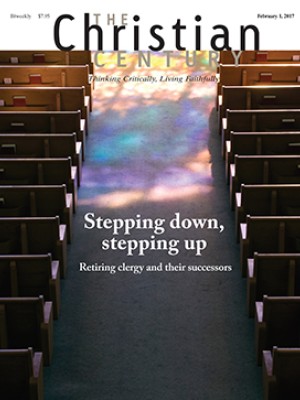At the pinnacle of the stained-glass windows in my college’s chapel, looming high above the majestic pipe organ in the balcony, is what students and alumni lovingly refer to as the transfiguration window. Jesus, clad in white and skin shining, stands astride a mountain next to Moses, Elijah, Peter, and James. Held within the mountain is the vision of the New Jerusalem from Revelation: the fire and the beasts, the elders with their crowns, the river of the water of life, and Jesus at the center enthroned and holding the seven churches in his hands. When the afternoon light hits this window just right, Jesus glows radiantly. It’s glorious.
All of it except the feet. Jesus’ feet in this window are decidedly not glorious. One might even describe them as ugly. They’re skinny and bony and pointy, with callouses. They look like the kind of feet that would smell bad. They are, in fact, nearly identical to the feet of the nondivine humans who stand next to Jesus on the mountain.
Read our latest issue or browse back issues.
God comes to earth, incarnate in a body, but it’s not a perfect body or even a stunningly beautiful body. It’s a human body with very real, very bony, probably very dusty and stinky feet. No transfiguration can change that fact. Yet it’s precisely in the juxtaposition of Jesus’ glory and his humanity that the story of the transfiguration may speak most clearly into a world filled with suffering and sin.
The juxtaposition is inscribed in the biblical narrative as a set of bookends. “Six days later,” begins Matthew’s version of the story, which leads to the question: Later than what? If you scroll back a few verses, you’ll see that Jesus has just predicted his passion in grave detail and enjoined his disciples to take up the cross. The short phrase “six days later” seems like a radically insufficient transition between the agony of the cross and the glory of a mountaintop theophany. That transitional space, brief as it is, embodies the lifelong paradox in which we find ourselves—always hovering between death and life, perpetually waiting for God to show up even as we find ourselves dazzled by the brilliance of grace.
We should neither underestimate this brilliance nor be surprised by it. We are, after all, at the end of a season defined by its epiphanies. Salvation has shone through a star. God has been revealed as light and life. Jesus has cured and healed people with indiscriminate generosity. It seems almost natural that Jesus would now display his supernatural power with a flashy pyrotechnic display, accompanied by a divine heavenly voice and flanked by seemingly resurrected prophets.
But the story’s second bookend, encapsulated in Jesus’ final words “risen from the dead,” reminds us that the glory is always mixed in with the earthy, the vulnerable, and the suffering. By the end of the story, this divine glowing human has told his disciples quite plainly (again) that he is going to die. Transfiguration is the pinnacle of Epiphany, but it’s also the doorway into Lent. And Lent reveals that the power of God manifests itself in weakness. God descended to earth in mortal frame, a man with bony, unattractive feet. And then this man descended farther, into weakness and conflict and rejection. And then he descended even farther, into death on a cross.
What a strange kind of glory this is: a divine power that refuses to hover above the earth in glorified form but instead climbs back down the mountain and walks straight toward crucifixion, one dusty foot in front of the other. Those skinny, smelly feet that have traversed hundreds of miles of dirt roads are, for a few brief moments, enveloped in a bright cloud of divine glory. And then they will be nailed to a cross.
The narrative of the cross, however, has bookends of its own: transfiguration and resurrection. So even before Lent begins, if we are grounded in the story of the transfiguration, we can also look ahead to the glory of the risen Christ. At the end of Matthew’s Gospel, the resurrected Jesus appears to Mary Magdalene and the other Mary as they run, with fear and great joy, to proclaim the resurrection to the disciples. When he speaks, they cling to his feet and worship him.
I’d like to think that this coexistence of divine glory and human suffering within a single body, represented by a pair of first-century feet, means something for our lives—perhaps even that it means everything for our lives. And I’d like to think that it means the most during those times when we are least optimistic, when we are least likely to be able to glimpse any beauty among the violence and selfishness that plague our society and mar our hearts.
When I preach on Transfiguration Sunday, I’m always tempted to quote Marilynne Robinson’s preacher character, John Amos, who says this in a sermon: “It has seemed to me sometimes as though the Lord breathes on this poor gray ember of Creation and it turns to radiance—for a moment or a year or the span of a life. . . . Wherever you turn your eyes the world can shine like transfiguration.” This doesn’t mean that we should expect all evil to be redeemed in a singular spectacular moment of divine intervention. It doesn’t mean we should wear rose-colored glasses to avoid the work of living ethically in a broken world. It doesn’t mean that we will get to glow like Jesus or float in a cloud of glory.
It does mean that there’s potential in the most ordinary places for transformation. It means that grace comes to us in mundane form: bread, a word, water, the stranger, a breeze, a pair of skinny feet. The promise of transfiguration is that the glory of God transforms our world—and us—from the inside out.







